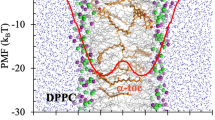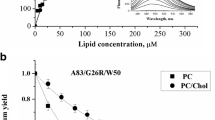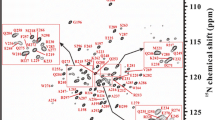Abstract
The fatty acid binding proteins (FAPBs) function as intracellular carriers of fatty acid (FA) and related compounds. During the digestion of lipids, the local concentration of FA exceeds their critical micellar concentration; the excess ratio of FA/FABP can be as high as ~1,000/1, consequently building micelles. Considering that the micelle formation is a rapid process, the FABP must be able to remove the mini-micelle. In this study, we describe the results of molecular dynamics simulations of liver basic FABP (Lb-FABP), carried out in the presence of ~20 mM palmitate ions, all in the presence of explicit water and at ionic strength of ~100 mM, approximating physiological conditions. The Lb-FABP appears to react, along with a free FA, with mini-micelle creating a stable complex (on the time scale of the simulations), which is attached to the anti-portal domain of the protein. The complex may be formed by the stepwise addition of free FA or through the interaction of a pre-formed mini-micelle with the free protein. The driving force of the mini-micelle-FABP complex is a combination of electrostatic attraction between the negative carboxylates of the mini-micelle with the positive charge of the N terminal amine residues and Lennard-Jones FA–protein interactions. The preferred tendency of the mini-micelle to react with the anti-portal domain retains the α-helixes of the portal region free for its electrostatic interaction with the membrane, ensuring a rapid unloading of the cargo on the membrane.




Similar content being viewed by others
References
Mansbach CM, Dowell RF (1992) Uptake and metabolism of circulating fatty acids by rat intestine. Am J Physiol 263:G927–G933
Bass NM, Manning JA, Ockner RK et al (1985) Regulation of the biosynthesis of two distinct fatty acid-binding proteins in rat liver and intestine. Influences of sex difference and of clofibrate. J Biol Chem 260:1432–1436
Haunerland NH, Spener F (2004) Fatty acid-binding proteins—insights from genetic manipulations. Prog Lipid Res 43:328–349. doi:10.1016/j.plipres.2004.05.001
Richieri GV, Ogata RT, Zimmerman AW et al (2000) Fatty acid binding proteins from different tissues show distinct patterns of fatty acid interactions. Biochemistry 39:7197–7204. doi:10.1021/bi000314z
Corsico B, Liou HL, Storch J (2004) The alpha-helical domain of liver fatty acid binding protein is responsible for the diffusion-mediated transfer of fatty acids to phospholipid membranes. Biochemistry 43:3600–3607. doi:10.1021/bi0357356
He Y, Yang X, Wang H et al (2007) Solution-state molecular structure of apo and oleate-liganded liver fatty acid-binding protein. Biochemistry 46:12543–12556. doi:10.1021/bi701092r
Likic VA, Prendergast FG (1999) Structure and dynamics of the fatty acid binding cavity in apo rat intestinal fatty acid binding protein. Protein Sci 8:1649–1657
Ory J, Kane CD, Simpson MA et al (1997) Biochemical and crystallographic analyses of a portal mutant of the adipocyte lipid-binding protein. J Biol Chem 272:9793–9801. doi:10.1074/jbc.272.15.9793
Sacchettini JC, Gordon JI, Banaszak LJ (1989) Crystal-structure of rat intestinal fatty-acid-binding protein—refinement and analysis of the Escherichia coli-derived protein with bound palmitate. J Mol Biol 208:327–339. doi:10.1016/0022-2836(89)90392-6
Wu F, Corsico B, Flach CR et al (2001) Deletion of the helical motif in the intestinal fatty acid-binding protein reduces its interactions with membrane monolayers: Brewster angle microscopy, IR reflection–absorption spectroscopy, and surface pressure studies. Biochemistry 40:1976–1983. doi:10.1021/bi002252i
Bakowies D, van Gunsteren WF (2002) Simulations of apo and holo-fatty acid binding protein: structure and dynamics of protein, ligand and internal water. J Mol Biol 315:713–736. doi:10.1006/jmbi.2001.5202
Likic VA, Juranic N, Macura S et al (2000) A “structural” water molecule in the family of fatty acid binding proteins. Protein Sci 9:497–504
Likic VA, Prendergast FG (2001) Dynamics of internal water in fatty acid binding protein: computer simulations and comparison with experiments. Proteins—Struct Funct Genet 43:65–72. doi:10.1002/1097-0134(20010401)43:1<65::AID-PROT1018>3.0.CO;2-F
Tsfadia Y, Friedman R, Kadmon J et al (2007) Molecular dynamics simulations of palmitate entry into the hydrophobic pocket of the fatty acid binding protein. FEBS Lett 581:1243–1247. doi:10.1016/j.febslet.2007.02.033
Friedman R, Nachliel E, Gutman M (2005) Molecular dynamics simulations of the adipocyte lipid binding protein reveal a novel entry site for the ligand. Biochemistry 44:4275–4283. doi:10.1021/bi048236t
Mihajlovic M, Lazaridis T (2007) Modeling fatty acid delivery from intestinal fatty acid binding protein to a membrane. Protein Sci 16:2042–2055. doi:10.1110/ps.072875307
Berendsen HJC, Vanderspoel D, Vandrunen R (1995) Gromacs—a message-passing parallel molecular-dynamics implementation. Comput Phys Commun 91:43–56. doi:10.1016/0010-4655(95)00042-E
Lindahl E, Hess B, van der Spoel D (2001) Gromacs 3.0: a package for molecular simulation and trajectory analysis. J Mol Model 7:306–317
Van der Spoel D, Lindahl E, Hess B et al (2005) GROMACS:fast, flexible, and free. J Comput Chem 26:1701–1718. doi:10.1002/jcc.20291
Oostenbrink C, Villa A, Mark AE et al (2004) A biomolecular force field based on the free enthalpy of hydration and solvation: the GROMOS force-field parameter sets 53A5 and 53A6. J Comput Chem 25:1656–1676. doi:10.1002/jcc.20090
Nichesola D, Perduca M, Capaldi S et al (2004) Crystal structure of chicken liver basic fatty acid-binding protein complexed with cholic acid. Biochemistry 43:14072–14079
Di Pietro SM, Corsico B, Perduca M et al (2003) Structural and biochemical characterization of toad liver fatty acid-binding protein. Biochemistry 42(27):8192–8203. doi:10.1021/bi034213n
Berman HM, Westbrook J, Feng Z et al (2000) The protein data bank. Nucleic Acids Res 28:235–242. doi:10.1093/nar/28.1.235
Mehrotra KN, Upadhyaya SK (1989) Ultrasonic measurements and other allied parameters of praseodymium and neodymium palmitates in mixed organic solvents. Colloid Polym Sci 267:741–747. doi:10.1007/BF01524378
Berendsen HJC, Postma JPM, van Gunsteren WF et al (1969) Interaction models for water in relation to protein hydration. Nature 224:175–177. doi:10.1038/224175a0
Hess B, Bekker H, Berendsen HJC et al (1997) LINCS: a linear constraint solver for molecular simulations. J Comput Chem 18:1463–1472. doi:10.1002/(SICI)1096-987X(199709)18:12<1463::AID-JCC4>3.0.CO;2-H
Miyamoto S, Kollman PA (1992) Settle: an analytical version of the shake and rattle algorithms for rigid water models. J Comput Chem 13:952–962. doi:10.1002/jcc.540130805
Berendsen HJC, Postma JPM, DiNola A et al (1984) Molecular dynamics with coupling to an external bath. J Chem Phys 81:3684–3690. doi:10.1063/1.448118
Darden T, York D, Pedersen L (1993) Particle mesh Ewald: an N-log(N) method for Ewald sums in large systems. J Chem Phys 98:10089–10092. doi:10.1063/1.464397
Humphrey W, Dalke A, Schulten K (1996) VMD: visual molecular dynamics. J Mol Graph 14:33–38. doi:10.1016/0263-7855(96)00018-5
Falomir-Lockhart LJ, Laborde L, Kahn PC et al (2006) Protein–membrane interaction and fatty acid transfer from intestinal fatty acid-binding protein to membranes: Support for a multistep process. J Biol Chem 281:13979–13989. doi:10.1074/jbc.M511943200
Corsico B, Franchini GR, Hsu KT et al (2005) Fatty acid transfer from intestinal fatty acid binding protein to membranes: electrostatic and hydrophobic interactions. J Lipid Res 46:1765–1772. doi:10.1194/jlr.M500140-JLR200
Author information
Authors and Affiliations
Corresponding author
Electronic supplementary material
Rights and permissions
About this article
Cite this article
Levin, L.BA., Nachliel, E., Gutman, M. et al. Molecular dynamics study of the interaction between fatty acid binding proteins with palmitate mini-micelles. Mol Cell Biochem 326, 29–33 (2009). https://doi.org/10.1007/s11010-008-0010-4
Received:
Accepted:
Published:
Issue Date:
DOI: https://doi.org/10.1007/s11010-008-0010-4




